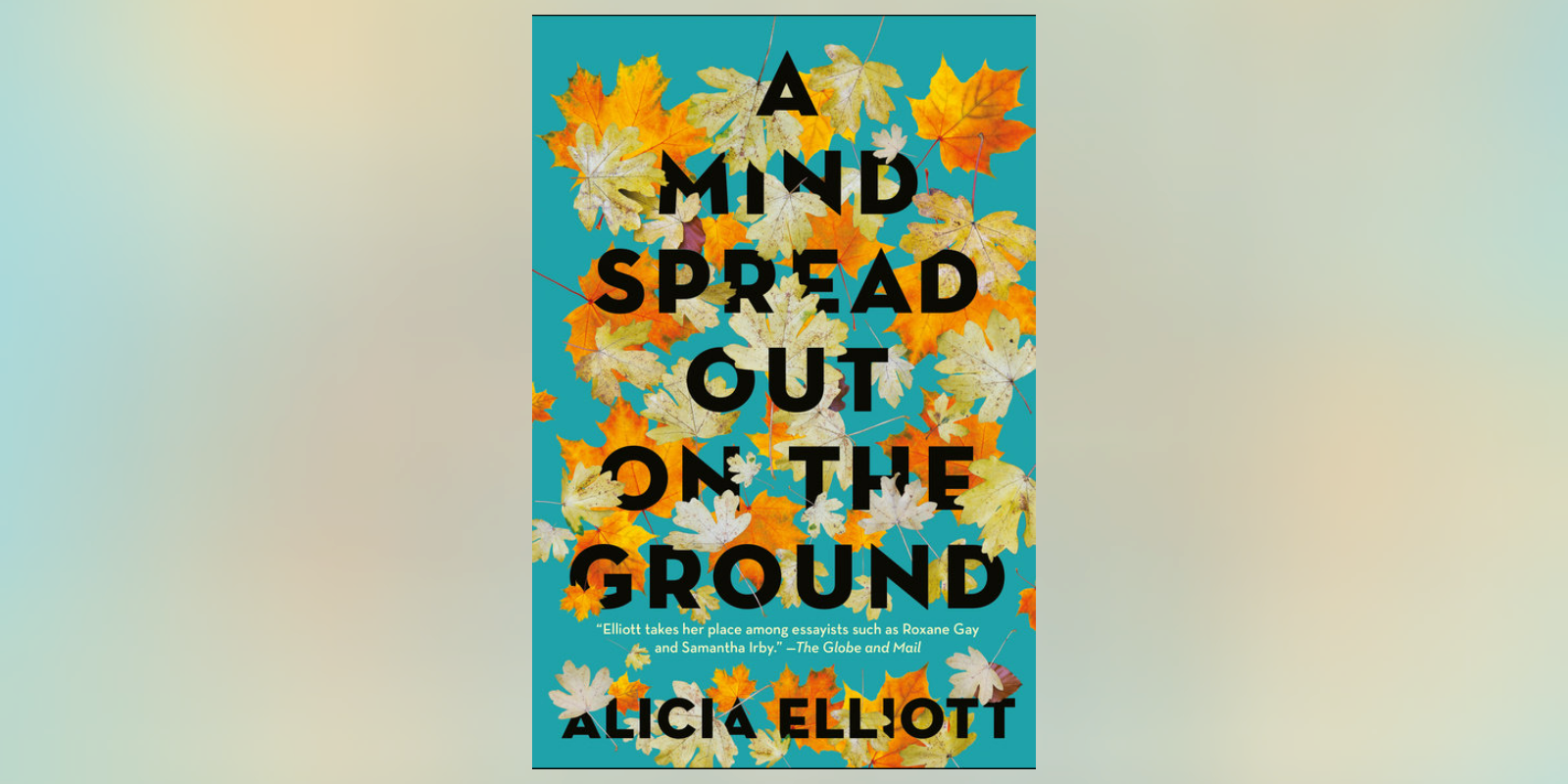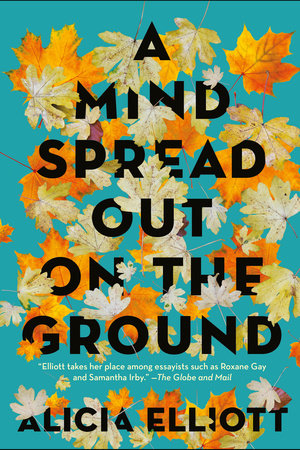The Mohawk phrase for depression can be roughly translated to “a mind spread out on the ground.” In this visceral memoir, Alicia Elliott explores how apt a description that is for the ongoing effects of personal, intergenerational, and colonial traumas she and so many Native people have experienced.
Elliott’s deeply personal writing details a life spent between Indigenous and white communities, a divide reflected in her own family, and engages with such wide-ranging topics as race, parenthood, love, art, mental illness, poverty, sexual assault, gentrification, and representation. Throughout, she makes thrilling connections both large and small between the past and present, the personal and political.
He took his glasses off and rubbed the bridge of his nose the way men in movies do whenever they encounter a particularly vexing woman.
“I’m really confused. You need to give me something here. What’s making you depressed?”
His reaction made me think briefly of residential schools—the state-mandated, church-run boarding schools Indigenous kids were sent to “kill the Indian, and save the man.” At the time I couldn’t understand the connection between the two. Maybe it was the fact that he operated his therapy sessions out of a church. That certainly didn’t help.
I wasn’t sure what to say. Can a metaphor or simile capture depression? It was definitely heavy, but could I really compare it to a weight? Weight in and of itself is not devastating; depression is. At times it made me short of breath and at times it had the potential to be deadly, but was it really like drowning? At least with drowning others could see the flailing limbs and splashing water and know you needed help. Depression could slip in entirely unnoticed and dress itself up as normalcy, so when it finally took hold others would be so surprised they wouldn’t know how to pull you to safety. They’d stand there staring—good-intentioned but helpless. Empathetic, perhaps, but mute.
Or, as in the case of this particularly unqualified therapist, angry and accusing. Not that I necessarily blame them. I’ve done the same thing.
When what was left of my family moved to the Six Nations of the Grand River reserve in Ontario, Canada, we lived in a two-bedroom trailer—my sister and I in the smaller room, my three younger brothers in the master bedroom. My parents had no bedroom, no bed. They slept in the living room on the couch and recliner. As one may assume of such circumstances, privacy was precious, if it existed at all. Doors never stayed closed for long; at any moment someone could barrel in unannounced. This meant there was no place for my mother to hide her illness.
I’d mostly known her as having bipolar disorder, though she’d been diagnosed and rediagnosed many times. Postpartum depression, manic depression, schizophrenia. Most recently, my mother has been diagnosed as having either schizoaffective disorder, which is a version of bipolar disorder with elements of schizophrenia, or post-traumatic stress disorder, depending on which doctor you talk to. None of these phrases gave her relief. In fact, they often seemed to hurt her, turning every feeling she had into yet another symptom of yet another disease.
What these words meant to my siblings and me was that our mother’s health was on a timer. We didn’t know when the timer would go off, but when it did, our happy, playful, hilarious mother would disappear behind a curtain and another would emerge: alternately angry and mournful, wired and lethargic. When she was depressed she’d become almost entirely silent. She’d lie on our brother’s bottom bunk and blink at us, her soft limp limbs spilling onto the stained, slate-coloured carpet. I’d sit on the floor beside her, smooth her hair—bottle-red with grey moving in like a slow tide—and ask her what was wrong. She’d stay silent but her face would transform. Damp, swollen, violet, as if the words she couldn’t say were bubbling beneath her skin, burning her up from the inside.
Terminology is tricky. Initially, depression was known as “melancholia,” a word that first brought to my mind a field of blue cornflower and golden hay. Its trochaic metre gave it an inherent poeticism, an ingrained elegance. It was delicate, feminine. Hamlet’s doomed lover, Ophelia, definitely did not suffer from depression. When she floated down that river, decked in garlands, stones in her pockets, she was in the throes of melancholia.
The term first appeared in Mesopotamian texts in the second century BCE. At the time, they considered melancholia a form of demonic possession. They weren’t alone: ancient Babylonian, Chinese, and Egyptian civilizations all attributed mental illness to demons overpowering the spiritually weak. Exorcism—which often entailed beatings, restraint, and starvation—was the only known “cure.” Even during the Renaissance, when thinking about depression began to reflect the more progressive views of the early Greek physician Hippocrates, a heavily Christian Europe had another way to describe those with mental illness: witches. They were “cured” by being burned at the stake. Sometimes, as part of their trial, suspected witches underwent an ordeal by water. They were tied to a rope and thrown from a boat. If they sank they’d be pulled back to a safety of sorts, their innocence proven, but their illness unchecked. If they floated, like Ophelia, they were considered a witch and summarily executed.
My quite Catholic mother believes demonic possession is a real danger. She pretty much used the 1973 film The Exorcist as an instructional video for my siblings and me. It was mostly effective. I played with a Ouija board only once, reluctantly, and though I remained firmly in control of my body, I still try to avoid the game (and pictures of Linda Blair) at all costs. I know demonic possession is impossible, probably, but it still scares me more than I’d like to admit.
So when my mother, now living in an adult care home in Florida, told me she was hearing demonic voices and thought she needed an exorcism, I was legitimately terrified. Not because I thought she was possessed—she didn’t mention anything about floating above her bed, and her voice sounded normal. I was scared for her. She truly believed demons were real and could take control of the spiritually weak. If she believed she was being overtaken by these demons, logic dictated that she was spiritually weak. As if her depressed mind didn’t have enough to guilt her with.
She wouldn’t tell me what the voices were saying to her. She just reiterated over and over that she was a sinner, that she had impure thoughts, that she hadn’t been going to church enough. None of this seemed to me like enough reason to call in an exorcist.
Evidently her priest down in Florida disagreed. He said it did, indeed, sound like she was in the midst of a spiritual battle, that she should contact the church about sending an exorcist right away. Though he himself was part of the Catholic Church, he never offered any assistance with her “spiritual battle,” never offered to bring in an exorcist to slay her inner demon. He just gave her his half-baked opinion like a torch and watched as she caught flame.
As far as analogies go, comparing depression to a demon is a pretty good one. Both overtake your faculties, leaving you disconnected and disembodied. Both change you so abruptly that even your loved ones barely recognize you. Both whisper evil words and malformed truths. Both scare most people shitless.
According to Diane Purkiss’s The Witch in History: Early Modern and Twentieth-Century Representations, European colonists widely considered Indigenous peoples to be devil worshippers. In fact, during the Salem witch trials, the people of the Sagamore tribe were blamed—described by early Puritan minister and mastermind of the witch trials, Cotton Mather, as “horrid sorcerers, and hellish conjurors . . . [who] conversed with Demons.” One person on trial claimed to have attended a black mass with the Sagamore Indians. Mercy Short, another accused witch, took it one step further: she claimed the Devil himself was an Indian, describing him as “not of a Negro, but of a tawny, or an Indian color.”
Literal demonizing of Indigenous people was a natural extension of early tactics used to move colonization along. In 1452 and 1455 the Catholic Church issued papal bulls calling for non-Christian people to be invaded, robbed, and enslaved under the premise that they were “enemies of Christ.” Forty years later, when Christopher Columbus accidentally arrived in the Americas, European monarchs began to expand on the ideas contained in those bulls, issuing policies and practices that have been collectively referred to as the Doctrine of Discovery. These new policies dictated that “devil-worshipping” Indigenous peoples worldwide should not even be thought of as humans, and thus the land they had cared for and inhabited for centuries was terra nullius, or vacant land, and Christian monarchs had the “right” to claim it all. The Doctrine of Discovery was such a tantalizing, seemingly guilt-free justification for genocide, even U.S. Secretary of State Thomas Jefferson adopted it as official policy in 1792—and we all know how much Americans wanted to distinguish themselves from Europe at the time.
The Doctrine of Discovery is still cited in court cases today whenever Canada or the U.S. want to shut up Indigenous tribes who complain. In an attempt to stop this lazy, racist rationale, a delegation of Indigenous people went to Rome in 2016 to ask the church to rescind these papal bulls. Kahnawake Mohawk Kenneth Deer said that after hearing their concerns, Pope Francis merely looked him in the eye and said, “I’ll pray for you.” Two years later, after the delegation’s second trip to Rome to discuss these papal bulls, they were told the matter was being sent to another committee. Nothing else has been done, though presumably the Pope is still praying for us.
“Can you imagine going to a funeral every day, maybe even two funerals, for five to ten years?” the Haudenosaunee chief asks. He’s giving a decolonization presentation, talking about the way colonization has affected our people since contact. Smallpox, tuberculosis, even the common cold hit our communities particularly hard. Then, on top of that, we had wars to contend with—some against the French, some against the British, some against either or neither or both. Back then death was all you could see, smell, hear, or taste. Death was all you could feel.
“What does that type of mourning, pain, and loss do to you?” he asks. We reflect on our own losses, our own mourning, our own pain. We say nothing.
After a moment he answers himself. “It creates numbness.”
Numbness is often how people describe their experience of depression.
I was sixteen when I wrote my first suicide note. I was alone in my room, for once. It was cold; the fire in our wood-burning stove must have gone out. I was huddled beneath the unzipped sleeping bag I used as a comforter, listening to the only modern rock station my ancient radio could pick up. The songs washed over me. My brothers laughing, crashing, and crying washed over me. My mother half-heartedly yelling at them while she watched a movie with my sister washed over me. My father’s absence washed over me.
Even though the trailer was full I was alone. I was alone and I felt nothing and it hurt so much. More than grief, more than anger. I just wanted it to end.
Tears fell on the paper faster than I could write. It was hard to read in parts. I didn’t care. As long as it reassured my family they shouldn’t blame themselves, it would do the trick.
I looked at the knife I’d smuggled from the kitchen, pressed its edge to my wrist. Nothing happened. The blade was too dull.
I’d have to stab hard and slash deep just to break the skin. I was crying so hard.
I reread my note. I looked back at the knife. Even though it could hardly peel a potato it scared me more than the void I felt.I lay back down, disgusted with myself and my lack of resolve. I tried to listen to the radio. I couldn’t hear anything.
Though suicide was quite rare for Onkwehon:we pre-contact, after contact and the subsequent effects of colonialism it has ballooned so much that, as of 2013, suicide and self-inflicted injuries were the leading cause of death for Native people living in Canada under the age of forty-four. A 2019 study revealed that, since 1999, the suicide rate among Native men living in the U.S. has gone up 71 percent. The suicide rate for Native women went up an even more staggering 139 percent. Native youth in America face a suicide rate 2.5 times the national average, with suicide being the second-leading cause of death for Native youth between the ages of ten and twenty-four. For LGBTQ2S+ Onkwehon:we, no data exists.
Interestingly, the Canadian Centre for Suicide Prevention has found lower rates of depression and suicide among communities that exhibit “cultural continuity.” This includes self-government, land control, control over education and cultural activities, and command of police, fire, and health services. In other words, the less Canada maintains its historical role as the abusive father, micromanaging and undermining First Nations at every turn, the better off the people are. Lower instances of suicide were also found in communities where more than 50 percent of the people spoke their Indigenous language. This probably isn’t much of a surprise to an Indigenous person. We know our cultures have meaning and worth, that our culture lives and breathes inside our languages.
The United States and Canada knew that, too. Which is why they fought so hard to make us forget them.
There are two scientific designations for depression. The droller, more scientific term for melancholia is “endogenous depression.” In contrast to exogenous, or reactive, depression—which stems from a major event such as divorce, job loss, or death in the family—melancholic depression has no apparent outside cause. In other words, it comes out of the blue. This is a rather ridiculous way of putting it when you consider that depression itself is sometimes referred to as “the blues.” The blues coming out of the blue. Go figure.
I’ve heard one person translate a Mohawk phrase for depression to, roughly, “his mind fell to the ground.” I ask my sister about this. She’s been studying Mohawk for the past three years and is practically fluent. She’s raising her daughter to be the same. They’re the first members of our family to speak the language since our paternal grandfather a handful of decades ago.
“Wake’nikonhra’kwenhtará:’on,” she says. “It’s not quite ‘fell to the ground.’ It’s more like, ‘His mind is . . .’” She pauses. She repeats the word in Mohawk. Slows it down. Considers what English words in her arsenal can best approximate the phrase. “‘His mind is . . .’” She moves her hands around, palms down, as if doing a large, messy finger painting. “Literally stretched or sprawled out on the ground. It’s all over.” She explains there’s another phrase, too. Wake’nikonhrèn:ton. It means “the mind is suspended.”
Both words indicate an inability to concentrate. That’s one of the signs of depression. I know because I’ve checked it off in the copy of Mind Over Mood I took out from the library. It says my depression currently scores a 32 out of a possible 57, or 56 percent. Not the worst. At least I’m not considering suicide. Suicidal thoughts is number ten on the checklist.
I’ve heard people say that when you learn a people’s language, you learn their culture. It tells you how they think of the world, how they experience it. That’s why translation is so difficult—you have to take one way of seeing the world and translate it to another, while still piecing the words together so they make sense.
Lately I’ve been thinking a lot about why there is no Mohawk word to differentiate between reactive and melancholic depression. No scientific jargon to legitimize and pathologize. Just wake’nikonhrèn:ton and wake’nikonhra’kwenhtará:’on. A mind hanging by a thread, and a mind spread out on the ground. A before and an after—the same way we measure ourselves against colonialism. What does that mean about our culture?
Copyright © 2020 by Alicia Elliott. All rights reserved. No part of this excerpt may be reproduced or reprinted without permission in writing from the publisher.

© Alex Jacobs-Blum
ALICIA ELLIOTT is a Mohawk writer and editor living in Brantford, Ontario. She has written for The Globe and Mail, CBC, Hazlitt and many others. She’s had numerous essays nominated for National Magazine Awards, winning Gold in 2017 and an honorable mention in 2020. Her short fiction was selected for Best American Short Stories 2018 (by Roxane Gay), Best Canadian Stories 2018 and Journey Prize Stories 30. Alicia was chosen by Tanya Talaga as the 2018 recipient of the RBC Taylor Emerging Writer Award. Her first book, A Mind Spread Out On The Ground, was a national bestseller in Canada. It was also nominated for the Hilary Weston Writers’ Trust Prize for Nonfiction and won the Forest of Reading Evergreen Award.






